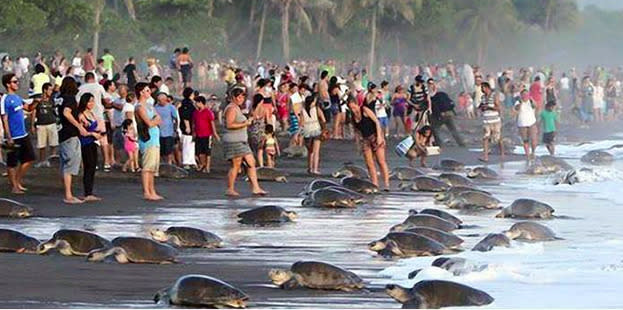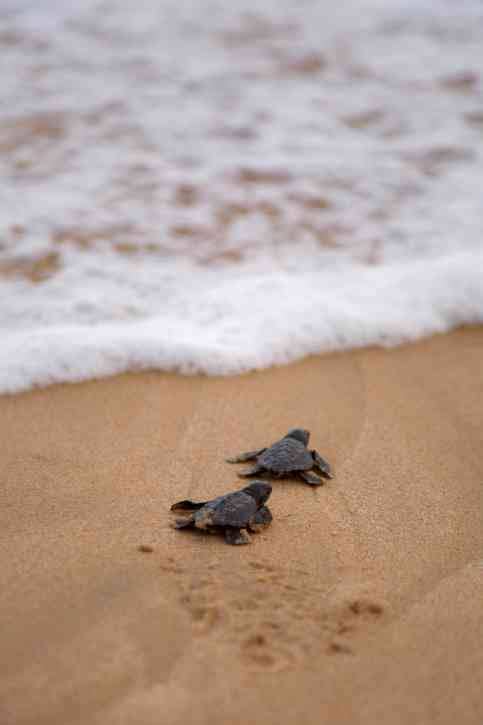6 Amazing Facts You Never Knew About Sea Turtles

Photo by Jody Watt/Design Pics/Corbis. Design by Erik Mace for Yahoo Travel.
This month, all over the southern U.S., Central America, and the Caribbean, thousands of tiny little sea turtle hatchlings are emerging from their eggs, digging their way to the surface of the sand, and scurrying down beaches to the ocean. We’re coming toward the end of sea turtle nesting season (March through October) in the western hemisphere, and there’s good news this year: Researchers say 2015 is shaping up to be a banner year for sea turtles from the Carolinas to Florida — their numbers have rebounded after a slump year, according to the Associated Press.
This season, I was lucky enough to participate in the yearly sea turtle conservation program at the Four Seasons Resort Nevis, which the hotel runs in conjunction with the Sea Turtle Conservancy (STC). (The 2016 dates are July 15-19; it’s not to be missed.) Along with David Godfrey, Executive Director at STC, local volunteer conservationists, and other resort guests, I spent hours each night walking Nevis’s beaches in the complete darkness (no flashlights allowed) hoping to see a sea turtle digging her nest and dropping her eggs. This year, we found two — Luna and Millie, both hawksbills. The turtles were tagged and released in order to help STC track them and gain valuable knowledge that will aid with future sea turtle conservation efforts. But more than just helping the cause and seeing the amazing sight of sea turtles nesting, I learned what fantastic creatures they are. Here are six amazing things you need to know about sea turtles.
1. There used to be millions of sea turtles in oceans around the world. Now there are thousands in limited areas.

This horrifying photo of tourists disturbing nesting sea turtles in Costa Rica is just one example of how we affect the amazing creatures. (Photo: Sea Turtle Conservancy/Facebook)
Some kinds of sea turtles have become extinct, and six of the surviving seven species are considered endangered. Unfortunately, it’s human behavior that’s obliterating them. Sure, before they are full-grown they have natural predators like sharks, but we’re the big problem. We encroach on their nesting beaches and hurt them and ruin their habitats with our excessive use of things like plastic and chemical sunblock. Additionally, while many nations have outlawed the international trade of seat turtles and sea turtle products (like real tortoise shell, which comes from sea turtles, not tortoises), in other places, it is not illegal to poach.
Related: 5 Ways Your Vacation Is Killing Sea Turtles
2. Experts believe that sea turtles can live to be about 100 years old.
There is no good way to determine the age of sea turtles other than their growth rates and their size. Their age is important to understand, because it explains one of the reasons why they are so vulnerable, according to STC’s Godfrey. It takes sea turtles a long time to reach sexual maturity so that they can reproduce, maybe as long as 30 or 35 years. “There are so many obstacles to their survival before reach that age,” explains Godfrey. Therefore the adult sea turtle population is very valuable within the eco system, because it takes so long for them to get there. Then they can continue to lay eggs until they die. Once they are fully mature, sea turtles’ only real predators are humans.
3. Turtles have GPS. (Seriously!)

Turtle GPS? (Photo: Thinkstock)
Sea turtles can sense the earth’s magnetic field, and that’s how they navigate. That basically means they have a built-in, high-tech GPS system, explains Godfrey. They detect the angle and the intensity of the field, which is unique every place on earth, and they use it to migrate very long distances — thousands of miles, in fact. They can find little islands in the middle of nowhere, says Godfrey. “That’s unbelievable for a reptile.”
Related: How to take the perfect Underwater Picture of a Sea Turtle
4. Female sea turtles return to the exact beach where they were born to nest, no matter how far away they live.
Thanks to their GPS, as well as some sort of map they are born with in their brains, female sea turtles return to their birth place to lay their eggs. Think about it: “These sea turtles only spent five minutes on the beach where they hatched, crawling down to the ocean,” explains Godfrey. They spent the next 30 or 35 years floating around the ocean [nesting is the only time they come on land], thousands of miles from where they were born. Yet they still find their way back to that very same beach after decades to lay their own eggs. “That’s why it’s so imp to protect their nesting habitats,” says Godfrey. “If 35 years later the beach where they were born is a bunch of condos, it’s a problem. They are driven to come back to the same site.”
5. Only 1 in 1,000 (and at times, possibly 1 in 10,000) baby sea turtles survive.

Hatchlings (Photo: Thinkstock)
Not only are the preyed upon by animals from raccoons to sharks, but development on the beaches where they are born can be deadly. When baby sea turtles hatch, they are drawn to the light, which is supposed to direct them in the direction of the ocean — an uninhabited beach will reflect the moon and stars off the water. However with development and lots of white lights, hatchlings get disoriented and often scurry in the wrong direction (away from the water towards the lights of civilization). If not redirected, they can easily die.
Related: Success! Nearly Extinct Sea Turtle Is Coming Back With the Help of Zoo
6. The sex of a baby sea turtle is determined by the temperature of the egg in which it was gestating.
More than that, the sex is determined by the temperature of the individual egg during a very small window of time during gestation. Cooler eggs (like those buried deeper down in the sand or more in the shade, become male. Warmer eggs, like those buried closer to the surface or in a sunnier area, become female. Due to global warming, experts are seeing an uptick in the number of female sea turtles born says Godfrey. (They’re not yet sure what this means for the well-being of the sea-turtle population in general.)
WATCH: Meet the Men Fighting to Save South Africa’s Rhinos from Poaching
Yahoo Travel inspire you every day. Hang out with us on Facebook, Twitter, Instagram, and Pinterest. Watch Yahoo Travel’s original series “A Broad Abroad."
For more on Yahoo Travel’s travel policy, click here.

